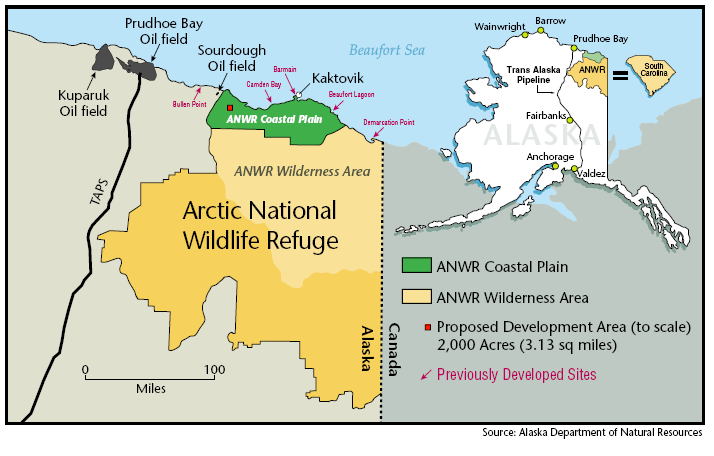Arctic National Wildlife Refuge
LOCATED IN northeastern ALASKA and managed by the U.S. Fish and Wildlife Service, the Arctic National Wildlife Refuge (ANWR) encompasses the largest diversity of wildlife of any protected area in the circumpolar north, earning it the nickname “the American Serengeti.” Efforts to preserve the refuge began in 1960 with the establishment of the Arctic National Wildlife Range.
Following passage of the Alaskan Lands Act in 1980, the area was renamed the Arctic National Wildlife Refuge and its size expanded to 20 million acres (8 million hectares), approximately the size of SOUTH CAROLINA. Included within the refuge are 8 million acres (3 million hectares) of wilderness land.

The ANWR is bounded to the east by CANADA and to the north by the Beaufort Sea. At its seaward margin is the flat and treeless Arctic coastal plain, extending inland for 40 mi (64 km). To the south of the coastal plains is the Brooks Range, an east-west band of mountains with several 9,000-ft (2,750-m) peaks. The rugged glacial topography of the range is interspersed with ice fields and wide, steep-sided valleys. An active layer of permafrost, or permanently frozen soil, is found in most areas of the refuge. Permafrost extends downward to an average of 1,000 ft (300 m). Some permafrost areas are underlain with patterned ground formed by polygons measuring 30 to 200 ft (9 to 61 m) in diameter. The shape of polygons is influenced by spring meltwater seeping into surface cracks and freezing.
The climate of the coastal plain is classified as Arctic or sub-Arctic with cool, cloudy summers. The average July temperature is 41 degrees F (5 degrees C ) and maximum temperatures rarely exceed 86 degrees F (30 degrees C). Winters are extremely cold, with February averaging -4 degrees F (-20 degrees C). High surface winds can result in windchill factors well below ambient temperatures. The Arctic plain receives an average of less than 10 in (25 cm) of precipitation. Two major biomes dominate the refuge: a northern boreal forest lying on the southern slope of the Brooks Range and Arctic tundra on the north slope. The ANWR has wildlife species common to the Arctic and sub-Arctic. More than 36 species of fish and nine marine mammals are represented in the refuge. Open range provides unconfined areas for large herds of porcupine caribou that migrate 800 mi (1,280 km) in May and June to ancestral calving areas on the coastal plain. In early July, they return to wintering areas to the south of the Brooks Range. Dall sheep can be found on mountainsides and musk oxen near water sources on coastal plains. Polar bears move onshore during the winter and return to sea ice in the spring months to hunt seals. Other ANWR mammals include lynx, voles, lemmings, and wolves. Proposals for petroleum drilling within the coastal plain have created controversy with regard to impacts on caribou and other wildlife in this Arctic region.
Bird nesting takes place between April and July. Represented within the refuge are the golden eagle, peregrine falcon, sandpiper, and plover. Migratory ducks and shorebirds begin collecting in lakes and lagoons in July to prepare for their migration to wintering areas in South America, Africa, Asia and the lower 48 U.S. states. Ptarmigan, dippers, and gyrfalcons are among the few species that remain in the refuge during the long Arctic winter.